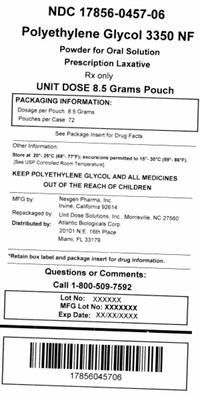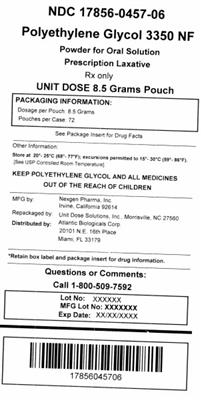Label: POLYETHYLENE GLYCOL 3350 powder, for solution
-
Contains inactivated NDC Code(s)
NDC Code(s): 17856-0457-1, 17856-0457-2, 17856-0457-3, 17856-0457-4, view more17856-0457-5, 17856-0457-6 - Packager: Atlantic Biologicals Corps
- This is a repackaged label.
- Source NDC Code(s): 51991-457
- Category: HUMAN PRESCRIPTION DRUG LABEL
- DEA Schedule: None
- Marketing Status: Abbreviated New Drug Application
Drug Label Information
Updated May 22, 2018
If you are a consumer or patient please visit this version.
- Download DRUG LABEL INFO: PDF XML
- Official Label (Printer Friendly)
-
DESCRIPTION
A white powder for reconstitution. Polyethylene Glycol 3350 NF (Polyethylene Glycol 3350 Powder For Oral Solution) is a synthetic polyglycol having an average molecular weight of 3350. The actual molecular weight is not less than 90.0 percent and not greater than 110.0 percent of the nominal value. The chemical formula is HO(C2H4O)nH in which n represents the average number of oxyethylene groups. Below 55°C it is a free flowing white powder freely soluble in water. Polyethylene Glycol 3350 NF is an osmotic agent for the treatment of constipation.
-
CLINICAL PHARMACOLOGY
Pharmacology
Polyethylene Glycol 3350 NF is an osmotic agent which causes water to be retained with the stool. Essentially, complete recovery of Polyethylene Glycol 3350 NF was shown in normal subjects without constipation. Attempts at recovery of Polyethylene Glycol 3350 NF in constipated patients resulted in incomplete and highly variable recovery. In vitro study showed indirectly that Polyethylene Glycol 3350 NF was not fermented into hydrogen or methane by the colonic microflora in human feces. Polyethylene Glycol 3350 NF appears to have no effect on the active absorption or secretion of glucose or electrolytes. There is no evidence of tachyphylaxis.
-
CLINICAL TRIALS
In one study, patients with less than 3 bowel movements per week were randomized to Polyethylene Glycol 3350 NF, 17 grams, or placebo for 14 days. An increase in bowel movement frequency was observed for both treatment groups during the first week of treatment. Polyethylene Glycol 3350 NF was statistically superior to placebo during the second week of treatment. In another study, patients with 3 bowel movements or less per week and/or less than 300 grams of stool per week were randomized to 2 dose levels of Polyethylene Glycol 3350 NF or placebo for 10 days each. Success was defined by an increase in both bowel movement frequency and daily stool weight. For both parameters, superiority of the 17 gram dose of Polyethylene Glycol 3350 NF over placebo was demonstrated.
- INDICATIONS AND USAGE
- CONTRAINDICATIONS
- WARNINGS
-
PRECAUTIONS
General
Patients presenting with complaints of constipation should have a thorough medical history and physical examination to detect associated metabolic, endocrine and neurogenic conditions and medications. A diagnostic evaluation should include a structural examination of the colon. Patients should be educated about good defecatory and eating habits (such as high fiber diets) and lifestyle changes (adequate dietary fiber and fluid intake, regular exercise) which may produce more regular bowel habits.
Polyethylene Glycol 3350 NF should be administered after being dissolved in approximately 4 to 8 ounces of water, juice, soda, coffee or tea.
Information for Patients
Polyethylene Glycol 3350 NF softens the stool and increases the frequency of bowel movements by retaining water in the stool. It should always be taken by mouth after being dissolved in 4 to 8 ounces of water, juice, soda, coffee, or tea. Should unusual cramps, bloating, or diarrhea occur, consult your physician.
Two to 4 days may be required to produce a bowel movement. This product should be used for 2 weeks or less or as directed by your physician. Prolonged, frequent or excessive use of Polyethylene Glycol 3350 NF may result in electrolyte imbalance and dependence on laxatives.
Carcinogenesis, Mutagenesis, Impairment of Fertility
Long term carcinogenicity studies, genetic toxicity studies or reproductive toxicity studies in animals have not been performed with Polyethylene Glycol 3350 NF.
Pregnancy
Category C
Animal reproductive studies have not been performed with Polyethylene Glycol 3350 NF.
It is also not known whether Polyethylene Glycol 3350 NF can cause fetal harm when administered to a pregnant woman, or can affect reproductive capacity. Polyethylene Glycol 3350 NF should only be administered to a pregnant woman if clearly needed.
Geriatric Use
There is no evidence for special considerations when Polyethylene Glycol 3350 NF is administered to elderly patients. In geriatric nursing home patients a higher incidence of diarrhea occurred at the recommended 17 g dose. If diarrhea occurs Polyethylene Glycol 3350 NF should be discontinued.
-
ADVERSE REACTIONS
Nausea, abdominal bloating, cramping and flatulence may occur. High doses may produce diarrhea and excessive stool frequency, particularly in elderly nursing home patients. Patients taking other medications containing polyethylene glycol have occasionally developed urticaria suggestive of an allergic reaction.
-
OVERDOSAGE
There have been no reports of accidental overdosage. In the event of overdosage, diarrhea would be the expected major event. If an overdose of drug occurred without concomitant ingestion of fluid, dehydration due to diarrhea may result. Medication should be terminated and free water administered. The oral LD50 is > 50 gm/kg in mice, rats and rabbits.
-
DOSAGE AND ADMINISTRATION
The usual dose is 17 grams (about 1 heaping tablespoon) of powder per day (or as directed by physician) in 4 to 8 ounces of water, juice, soda, coffee, or tea. Each bottle of Polyethylene Glycol 3350 NF is supplied with a dosing cup marked to contain 17 grams of laxative powder when filled to the indicated line. Two to 4 days (48 to 96 hours) may be required to produce a bowel movement.
-
HOW SUPPLIED
Product: 17856-0457
NDC: 17856-0457-1 17 g in a CUP / 72 in a CASE
NDC: 17856-0457-2 17 g in a POUCH / 72 in a CASE
NDC: 17856-0457-3 4 g in a POUCH / 72 in a CASE
NDC: 17856-0457-4 4.25 g in a POUCH / 72 in a CASE
NDC: 17856-0457-5 8.5 g in a CUP / 72 in a CASE
NDC: 17856-0457-6 8.5 g in a POUCH / 72 in a CASE
- SPL UNCLASSIFIED SECTION
-
PATIENT INFORMATION
Polyethylene Glycol 3350 NF (Polyethylene Glycol 3350 Powder for Oral Solution) is a prescription only laxative which has been prescribed by your physician to treat constipation. This product should only be used by the person for whom it was prescribed.
How to take
The dose is 17 grams each day or as directed by physician. It should always be taken by mouth. Measure the dose using the dosing cup (or use one heaping tablespoon of powder), stir and dissolve in a glass (4 to 8 oz) of water, juice, soda, coffee, or tea. Taking more than the prescribed dose may cause loss of fluid due to severe diarrhea.
How will it work
Polyethylene Glycol 3350 NF softens the stool and increases the frequency of bowel movements by retaining water in the stool. Your first bowel movement will usually happen in two to four days, although results may vary for individual patients.
How long should I take it
Polyethylene Glycol 3350 NF achieves its best results when used between one and two weeks. You may discontinue taking the drug after you had several satisfactory bowel movements. Should unusual cramps, bloating, or diarrhea occur, consult your physician. Polyethylene Glycol 3350 NF is intended for up to a two week course of therapy. You should not use for a longer time unless directed by your physician.
Next Steps
After successfully completing Polyethylene Glycol 3350 NF therapy (usually between one and two weeks), please discuss with your physician lifestyle changes which may produce more regular bowel habits (adequate dietary and fluid intake, regular exercise).
Who should NOT take Polyethylene Glycol 3350 NF
Polyethylene Glycol 3350 NF should not be used by children. It should not be used by pregnant women unless prescribed by a physician.
Side Effects/Drug Reactions
Occasionally, Polyethylene Glycol 3350 NF may cause nausea, stomach fullness, cramping, diarrhea and/or gas. Do not take if you have symptoms such as nausea, vomiting, abdominal pain or distention, which may be due to bowel obstruction. On rare occasions hives and skin rashes have been reported which are suggestive of an allergic reaction. If you get an allergic reaction you should discontinue the medication and call your physician. If you are allergic to polyethylene glycol, do not use this drug.
- POLYETHYLENE GLYCOL 3350 POWDER, FOR SOLUTION
-
INGREDIENTS AND APPEARANCE
POLYETHYLENE GLYCOL 3350
polyethylene glycol 3350 powder, for solutionProduct Information Product Type HUMAN PRESCRIPTION DRUG Item Code (Source) NDC:17856-0457(NDC:51991-457) Route of Administration ORAL Active Ingredient/Active Moiety Ingredient Name Basis of Strength Strength POLYETHYLENE GLYCOL 3350 (UNII: G2M7P15E5P) (POLYETHYLENE GLYCOL 3350 - UNII:G2M7P15E5P) POLYETHYLENE GLYCOL 3350 17 g in 17 g Product Characteristics Color WHITE (white powder) Score Shape Size Flavor Imprint Code Contains Packaging # Item Code Package Description Marketing Start Date Marketing End Date 1 NDC:17856-0457-1 72 in 1 CASE 03/01/2018 1 17 g in 1 CUP; Type 0: Not a Combination Product 2 NDC:17856-0457-2 72 in 1 CASE 03/01/2018 2 17 g in 1 POUCH; Type 0: Not a Combination Product 3 NDC:17856-0457-3 72 in 1 CASE 03/01/2018 3 4 g in 1 POUCH; Type 0: Not a Combination Product 4 NDC:17856-0457-4 72 in 1 CASE 03/01/2018 4 4.25 g in 1 POUCH; Type 0: Not a Combination Product 5 NDC:17856-0457-5 72 in 1 CASE 03/01/2018 5 8.5 g in 1 CUP; Type 0: Not a Combination Product 6 NDC:17856-0457-6 72 in 1 CASE 03/01/2018 6 8.5 g in 1 POUCH; Type 0: Not a Combination Product Marketing Information Marketing Category Application Number or Monograph Citation Marketing Start Date Marketing End Date ANDA ANDA077706 09/06/2006 Labeler - Atlantic Biologicals Corps (047437707) Establishment Name Address ID/FEI Business Operations Atlantic Biologicals Corps 047437707 RELABEL(17856-0457) , REPACK(17856-0457)


